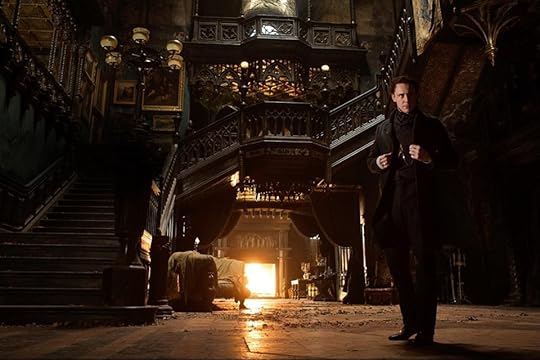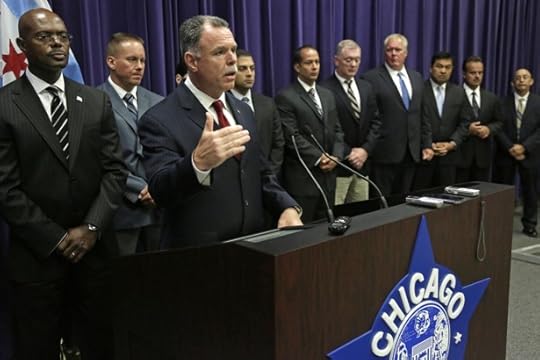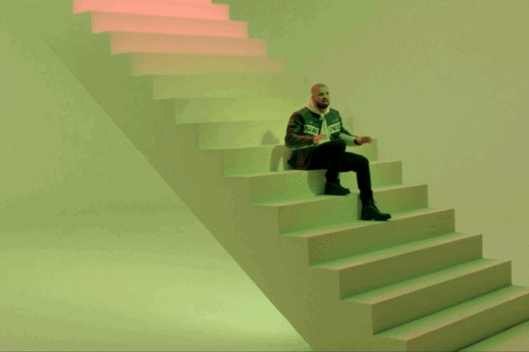Atlantic Monthly Contributors's Blog, page 316
October 22, 2015
A Deadly Raid in Iraq

Update on October 22 at 2:21 p.m. ET
An American soldier was killed Thursday in a raid by U.S. and Kurdish commandos on an Islamic State base in northern Iraq after receiving word that hostages captured by the militant group faced imminent mass execution, the Pentagon confirmed.
The service member was wounded in the operation, and subsequently died after receiving medical care, the Pentagon said. Four Kurdish Peshmerga fighters were wounded in the raid that resulted in the rescue of about 70 hostages and the capture of Islamic State fighters, the Pentagon said. A “significant number” of Islamic State fighters were also killed, Peter Cook, the Pentagon spokesman, told reporters.
A statement from the Kurdistan Regional Government said 69 hostages were freed. It put the number of Peshmerga injured at three. The hostages included 22 Iraqi security forces and a number of civilians. Cook said their identities are unclear.
The soldier became the first American service member killed in action in the country since the U.S. withdrawal from Iraq in 2011. Cook declined to say whether this was the first time U.S. forces were involved in fighting on the ground in Iraq since the withdrawal. He said this operation was unique, adding the U.S. role was restricted to training, advising, and assistance missions.
In a statement earlier, Cook said U.S. Special Operations Forces took part in the raid to rescue hostages at a Islamic State prison near Hawijah, Kirkuk province, following a request from the KRG.
“This operation was deliberately planned and launched after receiving information that the hostages faced imminent mass execution,” the statement said. “It was authorized consistent with our counter-ISIL effort to train, advise, and assist Iraqi forces.”
Here’s more:
The U.S. provided helicopter lift and accompanied Iraqi Peshmerga forces to the compound. Approximately 70 hostages were rescued including more than 20 members of the Iraqi Security Forces. Five ISIL terrorists were detained by the Iraqis and a number of ISIL terrorists were killed as well. In addition, the U.S. recovered important intelligence about ISIL.
U.S. troops entered the compound as part of the mission, Cook said. He said the operation was approved by Defense Secretary Ash Carter after a request from the KRG.









China’s No-Ghost Protocol Is Hampering Movie Flops

“Ghosts are real, that much I know,” is the first line spoken in Guillermo del Toro’s swooning Gothic thriller Crimson Peak, which opened to solid reviews but a tepid box office last weekend. In today’s global film economy, sub-par earnings in America don’t necessarily doom a film: Del Toro’s last effort, Pacific Rim, made up for its mediocre domestic performance by being a big hit overseas, especially in China. Producers are hoping the same will happen for Crimson Peak, but there’s one big problem. China’s Film Bureau doesn’t allow movies with ghosts in them, and certainly not movies that assert they’re “real.”
Related Story
‘Crimson Peak’: A Gothic Romance to Die For
The intricacies of getting a film approved by the China Film Bureau, an executive branch of the country’s Communist government, are largely unknown to Western audiences. Sometimes it can take months or years to secure a release; many major films have run afoul of unforeseen diplomatic pressures. In 2008, The Dark Knight’s planned rollout in China was cancelled because of “cultural sensitivities” (likely to do with scenes set in Hong Kong involving a money-laundering character), which significantly hampered the film’s worldwide box-office take. But Crimson Peak’s problem is an even bigger one. The Film Bureau objects to films with distinctly spiritual content, because they “promote cults or superstition” in violation of the Communist Party’s secular principles—a major problem for a movie chock-full of ghosts.
There are, apparently, ways around the “no ghosts!” rule. One easy way is to explain that the people seeing visions of the dead were crazy, perhaps, or on drugs. The second Pirates of the Caribbean film, Dead Man’s Chest, was banned in China because it had spirits swarming around, but Disney accordingly made cuts to the Chinese version of the series’ third film, At World’s End, to make it acceptable. Crimson Peak, though, is set in a haunted house literally teeming with ghosts—ghost babies, ghost brides, old lady ghosts, even main-character ghosts. The film can’t simply shake that off as a bad dream, and so, even though the film has been hyped by two of China’s most popular film websites (according to The Hollywood Reporter), it may never get a legitimate release there.
This wouldn’t have been a problem even 10 years ago, when even the most successful Chinese releases only earned tens of millions of dollars—not much by Hollywood standards. But as the China Film Bureau started allowing more U.S. productions into theaters, more movie theaters were built around the country, and its annual box-office numbers exploded. In 2007, the highest grossing film in China was Transformers, which made $37 million. This year, it was Furious 7, which took $390 million. Del Toro’s Pacific Rim made $101 million in the United States in 2013 on a $190 million budget. But it took $111 million in China, nudging it into profitable territory. That kind of haul can rescue a film, even if it’s seen as a box-office failure in its home country.
Part of the reason for Pacific Rim’s success overseas was its inclusion of Chinese characters. Some blockbusters have started filming scenes that are inserted only in Chinese cuts, like Iron Man 3, which had a whole subplot that American audiences will never see. Reaction to the China-specific scenes, which were apparently inserted rather awkwardly, were reportedly mixed. But it helped carry the Marvel movie to an impressive $121 million take in the country. Other recent films, like Gravity, 2012, and Transformers: Age of Extinction, have benefited from including scenes that depict cooperation with Chinese characters.
Within a few years, the Chinese film market may overtake America as the world’s biggest, and such story tweaks might become more and more noticeable. It’s also possible the China Film Bureau will continue to relax its standards to keep up with changing trends and stay ahead of piracy within its borders. A more concerning trend to watch for will be whether Hollywood becomes reluctant to produce big-budget films that won’t sell overseas. As Birth Movies Death’s Devin Faraci points out, Marvel has Doctor Strange on its docket in 2016, which will be full of ghosts—maybe in a few years, that’ll be a harder sell for a big studio. Then again, they can always splice in a scene explaining that it was all a dream.









The Inevitable Decline of Peyton Manning

Midway through the fourth quarter of Sunday’s game against the Cleveland Browns, the Denver Broncos quarterback Peyton Manning took a shotgun snap from the Broncos’ own 25-yard line. He shuffled his 39-year-old, six-foot-five-inch frame back a couple steps, then forward, and then let go of a low throw aimed at the right sideline, where the Denver speedster Emmanuel Sanders was presently streaking. The pass was perfect. It snuck just over the turned shoulder of a Cleveland cornerback and arrived before the helping safety could offer any aid, settling into Sanders’s grip as easily as if he’d been tossed a set of keys.
In other words, it looked like the type of throw with which Manning was once synonymous, the type made possible by virtuosic skill and foresight bordering on precognition. These throws had turned defenses’ fissures into gaping and exploitable openings and put point totals in the 30s or 40s on scoreboards across the NFL. This latest exhibition was placed so well that Sanders could catch it without decelerating and run the field’s remaining 50 yards for a touchdown.
This season, though, such passes are far rarer than they used to be. Manning’s fourth-quarter strike to Sanders on Sunday came minutes after his second interception of the day, returned by the Cleveland defense for a touchdown, and before his third. It was a much needed, dramatic salvo in a close game against a mediocre team that in years past would have played the role of patsy in a Manning-engineered blowout. On Sunday afternoon, as on most of the Broncos’ Sundays so far this season, the response the once-great quarterback inspired wasn’t awe but ambivalence—about his remaining aptitude, his health, his place on his team and within his sport, and the barbarous essence of the sport itself.
Manning is old and hurt. He underwent spinal-fusion surgery in 2011, which facilitated the end of his illustrious career with the Indianapolis Colts (featuring a Super Bowl title and four Most Valuable Player awards) and the beginning of his accomplished late-career run with the Broncos (a Super Bowl appearance, another MVP). The operation led to immediate changes in his abilities and tactics—wobblier spirals, shorter passes, a heightened disinclination to take big hits—but those changes have since been magnified to an extreme.
Some of his passes this season have been torturously slow or misaimed, and he curls and tumbles at the approach of a defensive lineman as if to protect a skeleton made of chalk. In late summer, near the end of the preseason, Manning admitted that the fingertips of his throwing hand have been numb ever since his return four seasons ago, and in September, ESPN The Magazine ran a profile of the player in which the normal routine of undressing after a game was revealed to be more arduous to him now than throwing an out-route against a top-flight defense once was.
From the perspective of pure football, the present situation of Manning and the Broncos is an interesting one. Despite Manning’s struggles, Denver holds a record of 6-0. A league-best defense and a cadre of highly skilled receivers, once considered networks of support to their quarterback’s distinct genius, now do most of the weekly work, with Manning chipping in where he’s able. One effect of this inversion of roles is that the Broncos seem somewhat anachronistic, a low-scoring and hard-hitting team in a league built (owing in no small part to Manning’s own influence) on prodigious passers.
But because football is a grim and violent game, Manning’s swan song is no harmless experiment. Each of his drop-backs triggers a hint of fear, from the viewer if not from the player himself. The words spine and neck linger, and nightmare scenes of paralysis flash. His slow and lanky limbs seem ready to fall apart at the slightest knock. Manning once stood for a certain kind of football future, chess played with human bodies—hazardous, sure, but fundamentally artful and intellectual. Now he stands for the game’s very real and very dangerous present.
* * *
In the prime of his career, Manning seemed lab-built to fulfill the needs of the NFL, in regards to both the evolution of the sport itself and its family- and advertiser-friendly, corporate-synergistic sheen. He was a generational talent, and an even rarer character in the ongoing story in which football positions itself as an outlet for American gumption. The old, hard times called for hard heroes, men who hit and scowled and spit out their teeth, but by the end of the 20th century and the start of the 21st, the nature of the country and its appetite for injury as entertainment had changed, however slightly. Football needed a star who could make its virtues—hard work, leadership, sacrifice—more modern, and maybe a little gentler.
So in stepped Manning. His ethic challenged that of any icon of yesteryear, but he showed it by logging long hours in the film room instead of by playing through cracked bones or torn muscles. Studio shows filled pregame airtime with stories of his obsessive preparation, and his gesticulating, heavily coded audibles at the line fascinated fans. When one of his passes found its target, it seemed a triumph of a new sort of gridiron archetype, with mental diligence replacing physical toughness as the defining characteristic.
When one of his passes found its target, it seemed a triumph of a new sort of gridiron archetype.Manning had the sort of physique and manner that, were he not a world-renowned superstar, might be called dweeby. He was gangly and seemed to play in borrowed, ill-fitting pads. He had a massive forehead that featured a red, pressure-induced spot whenever he removed his helmet and revealed his Tintin-like haircut. Neither quick nor fluid, he moved about the pocket as if stepping barefoot on summertime blacktop, and even at its best, his throwing motion looked overstudied, even a touch robotic.
This inelegant bodily style combined with Manning’s workaholic lore to place him firmly in the camp of the cerebral athlete. He had enviable physical gifts, of course, but he played in a way that made his body itself seem little more than a conduit for his mind. Watching him direct the whirring Colts teams of the 2000s, you couldn’t help but think that a notable portion of the NFL’s quarterbacks could make many of the throws Manning did. What they couldn’t do was see the angles or alleys of space as he saw them or, better yet, foresee what those angles and alleys would look like before they’d even materialized.
Now, it’s plain how much physical ability Manning did have in those days, and how much he had to lose. If he once seemed bookish as he played, he now resembles a disembodied brain suspended in a jar, with a rudimentary mechanical arm jerry-rigged outside the glass. An offense stuffed with talent surrounds him, and it’s all he can do to cobble together, via his gifts for prediction and misdirection and some short and shaky throws, enough yards for a first down. The Denver defense, founded on the pass-rushing menaces Von Miller and DeMarcus Ware, works at a feverish clip to make Manning’s slim leads hold or give him time to recover from his mistakes.
Set next to high-scoring feats of the nimble and rocket-armed Aaron Rodgers of the Green Bay Packers or the clinical Tom Brady of the New England Patriots, the halting efforts of Manning and the Broncos may seem inadequate. They’ll almost certainly prove to be so as the season wears on, when the stakes and levels of competition rise and shortcomings are less easily papered over. For now, though, they also illuminate aspects of the brilliance of team and player alike. The Broncos have demonstrated their ability to win, if not thrive, with a diminished version of their Hall of Fame-bound quarterback. Manning, for his part, has reshaped the meaning of endurance just as he did that of ethic over a decade ago.
* * *
Any admiration this season produces, though, is undermined by the reality of Manning’s physical condition. A pair of plays from a recent game in Oakland against the Raiders, one that ended in a 16-10 Broncos win, illustrates the queasiness sometimes caused by watching the sunset-riding QB. In the first, Manning was driving the Broncos down the field just before the half in pursuit of a clock-beating score. A play-action pass called for Manning to execute a fake hand-off before targeting a receiver with a throw. It was the kind of common maneuver that usually doesn’t attract much attention, but when Manning did it, it looked exceedingly difficult. He completed the pass, but that minor wrinkle in his usual routine—the pausing of the feet, the rotating of the shoulders to extend the ball and bring it back—rendered his degeneration stark. Among the lineman shoving and batting at one another and the receivers and defensive backs sprinting in tandem, he looked as incongruous as a spectator who’d accidentally wandered onto a speedway in the middle of a race.
Today’s Manning, though, shows the limits of the balletic shift for which he once served as figurehead.The second play came just after halftime, when the Raiders had the ball. The Oakland quarterback Derek Carr dropped back to pass, and Miller, the Denver linebacker, shed a blocker and came blazing toward him. Miller reached Carr in a blink and drove him to the ground and wrested the ball from his hands all in one motion. It was fast, efficient, and final.
I couldn’t help but wonder, watching this display of dominance so closely following Manning’s stiff and awkward shamble: What would have happened if it had been Manning staring down the unchecked defender? Would he have had time to execute one of his protective rolls? Would he have been able to toss the ball to an unoccupied patch of grass and skip out of the way? Or would his efforts to evade or absorb only have brought a weakened vertebra in line with the crown of the defender’s helmet and led to a gruesome outcome that, in retrospect, would have seemed inevitable?
This is the dark undercurrent of Manning’s hanging-on. Manning is, by sight if not by the technicalities of team medical clearance, unfit to be on an NFL field. But tragic as a severe injury would be, it would also be in keeping with a time in which football’s destructive capacity has never been more recognized. The word “concussion” is now spoken during each game, a new hobbled ex-player brings a suit against the NFL in every news cycle, and the league’s attempts to enforce safer tackling regulations read as insubstantial correctives to an inherently perilous sport.
Manning was once the blueprint for a kind of football less aesthetically centered on the hard hit, to the delight of its marketers and fans with more insistent consciences. Under his supervision, the game seemed like nothing so much as the anthropomorphization of a playbook, all patterned lines and practiced reactions and timed throws. It looked shiny, slightly unreal, and comparatively painless. Today’s Manning, though, shows the limits of the balletic shift for which he once served as figurehead. Football still resolves in bodies colliding, and so it still inspires fear.
In many ways, then, the departing Manning sheds a truer light than he did in his glory days on the conflicted experience of watching our national game. It inspires equal parts joy and guilt, not always easily separable from one another. Where we once watched Manning for his expertise, his peerless stature among the NFL’s players, we now see in him a kind of overview of the sport’s emotional terrain. We parse his remaining ability, admire his resolve, and worry over his future. And we hope he gets out in one piece, without that worry hardening into the last and most trying of football’s outputs: mourning.









Call It a McComeback?

The Golden Arches of the universe are long, but despite recent woes, they still seem to bend toward profitability.
On Thursday, McDonald’s stores showed quarterly growth for the first time in two years, exceeding expectations and causing shares to jump 7 percent. Global comparable sales for the company surged 4 percent and domestic comparable sales jumped 0.9 percent, defying a projected loss of a 0.2 percent.
The company says it owes its first signs of a turnaround to a return of demand in China, following a tainted meat scandal that gripped the country last year, as well as the popularity of the new Premium Buttermilk Crispy Chicken Deluxe sandwich.
Also, the paring down of menu items and some shifts in food preparation have given sales a boost.
McDonald's CEO says Egg McMuffin sales rose by double digit percentage after switching to butter from margarine. $MCD
— Phil Wahba (@philwahba) October 22, 2015
The surprising results undercut the extended speculation about the company’s decline. Since introducing its new CEO Steve Easterbrook earlier this year, McDonald’s has also helped to squelch the grease fire by reaching at the mantle of progressivism that have made its fast-casual competitors so successful.
Among the steps taken in the past few months alone, the company has pledged to shift to cage-free eggs, given raises to employees in company-run stores, made real the starry-eyed dream of all-day breakfast, and announced the phasing out of chicken raised with antibiotics. For now, it seems to be working.









A New Approach to Criminal-Justice Reform

Criminal-justice reform is taking a significant step forward this week. On Wednesday, more than 130 police chiefs and prosecutors announced a new organization with the goal of curtailing mass incarceration. President Obama will host a discussion with its members and the Marshall Project on Thursday, while the Senate Judiciary Committee plans to vote on the Smarter Sentencing Act, which hopes to reform mandatory-minimum sentencing and the federal prison system.
The group, Law Enforcement Leaders to Reduce Crime and Incarceration, is a project by the Brennan Center for Justice, a nonpartisan policy institute that specializes in legal and criminal-justice issues. The new group’s membership includes NYPD Commissioner Bill Bratton, Cook County District Attorney Anita Alvarez, New York Attorney General Eric Schneiderman, and Philadelphia police commissioner Charles Ramsey.
“We know firsthand that more incarceration does not keep our country safe,” Garry McCarthy and Ronal Serpas, the group’s co-chairs, wrote in a USA Today op-ed on Wednesday. “Our experience and research show that good crime control policy is not about locking up everyone. It’s about locking up the right people.”
The group’s four main issues draw upon many of the themes that have animated criminal-justice reform. They note that “more than 50 percent of prison and jail inmates have a diagnosed mental illness, and 65 percent of prisoners meet medical criteria for substance abuse and addiction,” citing successful efforts to rework the system in Miami’s courts. They praise California’s Proposition 47, which reduced a broad swath of nonviolent drug crimes from felonies to misdemeanors, as well as sentencing reforms in Georgia, Kentucky, and New York. And they cite the need for closer relationships between law-enforcement agencies and the communities they serve.
There are also notable omissions. While legislation binds many aspects of sentencing and determines the scope of criminalization, police chiefs and prosecutors are also empowered with significant discretion to make changes on their own. The group’s policies do not mention civil-asset forfeiture or bail reform, for example, though those issues fall under police and prosecutorial authority in most jurisdictions.
The group’s formation comes as the Senate Judiciary Committee prepares to vote on the Smarter Sentencing Act, a bipartisan bill hailed as a first step toward reducing federal prison populations and reforming mandatory-minimum sentencing. The proposed legislation is the product of lengthy negotiations between reform-oriented senators like Mike Lee of Utah and Cory Booker of New Jersey and more skeptical legislators like Senate Judiciary chairman Chuck Grassley of Iowa. Although the Act is less ambitious than some of its earlier incarnations, it nonetheless represents the first serious effort by Congress to systematically address criminal-justice reform at the federal level.
Obama is also slated to make criminal-justice reform a focus of his presidency as it enters its final year. “Ever since I was a senator, I’ve talked about how, in too many cases, our criminal-justice system is a pipeline from underfunded schools to overcrowded jails,” he said in his weekly radio address on October 17 as he announced a nationwide tour to highlight specific issues.
His first stop in Charleston, West Virginia, focused on prescription-painkiller abuse and addiction treatment. On Thursday, he will take part in a conversation with Charlie Beck, the Los Angeles police chief, and John Walsh, the U.S. attorney for the District of Colorado, moderated by Bill Keller, the Marshall Project’s editor in chief.









European Refugee Crisis: A ‘Systematic’ Violation of Human Rights

The UN human-rights commissioner has accused the Czech Republic of a systematic violation of the human rights of migrants and refugees in order to deter them from coming to the country.
Measures cited by Zeid Ra’ad Al Hussein include strip-searching migrants and refugees in order to confiscate money that is then used to pay for their detention, which can last up to 90 days.
“According to credible reports from various sources, the violations of the human rights of migrants are neither isolated nor coincidental, but systematic: They appear to be an integral part of a policy by the Czech Government designed to deter migrants and refugees from entering the country or staying there,” Zeid said in a statement issued in Geneva.
Many migrants and refugees are fleeing the civil war in Syria and unrest elsewhere, and are making their way to safety in Europe. Their preferred destination is Germany, which has opened its doors to those fleeing the conflict in Syria. But to get there, the migrants and refugees must first traverse Central European states, many of which have adopted policies, including border closures, that restrict the new arrivals.
In his statement, Zeid noted these restrictions, and added, “the Czech Republic is unique in routinely subjecting these migrants and refugees to detention for 40 days, and reportedly sometimes even longer—up to 90 days—in conditions which have been described as degrading.”
He also expressed concern about the Czech detention facilities where the migrants and refugees are being held, particularly Bìlá-Jezovqá—a facility that Robert Pelikán, the Czech justice minister, said was “worse than a prison.” Pelikán has also criticized the detention of the migrants and refugees for up to 90 days.
Zeid noted those migrants and refugees who have challenged their detention in court have prevailed, but most aren’t in a position to go to court either because they lack information about their right to free legal aid or because civil-society groups that work with them are given restricted access at some detention facilities.
The center-left Czech government’s practices have been criticized by its own ombudsman, Anna Šabatová, who in a report this month noted that the treatment of children at the detention centers violated the Convention on the Rights of the Child.
Zeid’s statement also said refugees and migrants were strip-searched by the authorities looking to confiscate money in order to pay the approximately $10 per day each person is charged for his or her detention. It said there were no clear legal grounds for such a step.
“The fact that people are being forced to pay for their own detention is particularly reprehensible,” Zeid said.
The UN commissioner for human rights also criticized President Miloš Zeman’s remarks about Muslims and the “Against Immigration” public petition started by Václav Klaus, the former Czech president.
Zeman has said the newcomers will impose Shariah law in the Czech Republic. Last week, he was quoted as saying: “We will lose women’s beauty because they will be covered head to toe in burqas, with only a fabric net over the face.”
His spokesman rejected Zeid’s criticism, telling Reuters: “The president has long warned of the threat of Islamic fundamentalism. He stands by his opinion and he will not change it under pressure from abroad.”









Who's Burning Black Churches in St. Louis?
Overnight companies extinguished this #church #fire; 4700blk of Plover. Investigation is ongoing. #STLCity pic.twitter.com/BqopqOqOib
— STLFD PIO (@STLFireDept) October 17, 2015
For the second time in six months, black churches are burning.
There have been six fires since October 8, all within a few miles of each other around St. Louis. Five have been at predominantly black churches, while the sixth was at a mixed church. Each fire has been set at the door, and while most have done minimal damage—one pastor called them “amateur hour” arsons—one nearly destroyed a building.
The situation is not unlike the arsons that followed the massacre at Emanuel A.M.E. Church in Charleston this summer. As The Atlantic pointed out at the time, there’s a long history of terrorism against black churches in America, one that begins in the era of slavery and continues up through Reconstruction, the civil-rights era, and into the 1990s. But unlike those burnings—and despite the intense focus on the St. Louis area since the August 2014 death of Michael Brown in Ferguson—the recent arsons have been slow to get the same attention, either in the national media or even in the area.
Related Story
Thugs and Terrorists Have Attacked Black Churches for Generations
If a series of attacks on churches is terrorizing, support from within the community and the nation is one comfort. Facing the attacks mostly alone seems to grate on some of the churches.
“People should be standing up and saying, ‘Hey I’m with you,’” the Revered Rodrick Burton, the pastor of one targeted church, told The Washington Post. “I’ve been surprised at the apathetic response. To me, it’s very telling, very disappointing.”
Burnings of black churches has often been a tactic for white supremacist groups. In 1995 and 1996, dozens of churches burned in the South. A special Justice Department task force eventually obtained hundreds of convictions, including Ku Klux Klan members who burned South Carolina churches. But as Emma Green pointed out in June, there are a stunning number of intentional fires at houses of worship each year—around 280 annually between 2007 and 2011—and the motives are sometimes hard to prove. Many are a result of racial animus. Some are simply set by firebugs. In some occasions, what looks initially like arson turns out to be accident. In July, during the summer arson spree, Mount Zion A.M.E. in Greeleyville, South Carolina, which had been burned in the 1990s arsons, again caught fire and was destroyed. But law-enforcement officials later determined that Mount Zion’s fire wasn’t a crime.
The Bureau of Alcohol, Tobacco, and Firearms and Explosives is investigating the fires. In a statement, the agency said, “We believe that this fire-setting activity is meant to send a message,” but it didn’t specify a message. ATF also said “this activity may be the result of stress experienced in the subject’s life” and said to be on the lookout for anyone who has “expressed anger or frustration with our religious community.”
“Whether you practice faith or you don’t, everyone should be very concerned about that.”In the aftermath of the Charleston shooting, a partisan divide emerged (mostly, it must be said, among white politicians and commentators) over whether the attacks were mostly a case of racial animus—after all, Dylann Roof was a self-proclaimed white supremacist who said he wished to start a race war—or whether it was an attack on Christianity, since it struck a church.
What’s interesting is how leaders of these churches deal with that dichotomy. By and large, they refuse to even countenance the idea that there might be a divide.
“This is a spiritually sick person,” said the Reverend David Triggs of New Life Missionary Baptist Church. “This is a sin issue. It’s not a race issue.” He elaborated to the Post: “It could be a black man coming against black churches. We don’t know if there’s any race barrier to this; but we know it is a sin issue and it has to be addressed as such—through prayer.”
“We are upset and we’re concerned that there’s an individual who, for whatever reason, is sick,” Michele Brown, business manager at St. Augustine Catholic Church, told the AP. “We prayed for them Sunday. There’s something wrong with someone who would do something like that.”
Burton told As It Happens that many of his congregants were old enough to remember the tense days of the civil-rights struggle, and were watching to see if there was proof of a racial motive with “bated breath.” But he also portrayed the arsons as an assault on faith, and expressed disappointment that more local churches, synagogues, and mosques hadn’t reached out in solidarity.
“Whether you practice faith or you don’t, everyone should be very concerned about that,” Burton told the AP. “Religious freedom is part of our identity as Americans.”









Paul Ryan's Uneasy Alliance With the House Freedom Caucus

The swift conservative backlash to Paul Ryan's highly-conditional bid for House speaker is best understood this way: In order to accept the job, Ryan needed to win a compromise from the no-compromise caucus.
On Wednesday night, he took a big step toward achieving just that, when a strong majority of the hardline House Freedom Caucus backed his candidacy. Importantly, it was less than the formal endorsement Ryan wanted, which requires support from 80 percent of the group. But the Wisconsin lawmaker was not prepared to quibble over a few holdouts, and he now is poised to take the party’s nomination when it votes in secret on October 28.
Yet what remains unresolved, and what will test whether this uneasy alliance is a durable one, is whether the Freedom Caucus conservatives will allow Ryan to lead the House under the unique terms he set. In exchange for accepting a position that most—but not all—Republicans begged him to take, Ryan sought a few key concessions: He wants near-unanimous support from the party; he wants to be able to spend time with his family rather than fund-raise every weekend; and he wants changes to the rules that would make it harder, if not impossible, for rank-and-file lawmakers to depose him on the House floor through a “motion to vacate the chair” if they don’t get what they want.
“No matter who is speaker, they cannot be successful with this weapon pointed at them all the time,” said Ryan spokesman Brendan Buck when describing Ryan’s request to Republicans in a private meeting on Tuesday night.
The Freedom Caucus may have given Ryan its support for the speakership, but it has not endorsed this procedural change.
After all, it was that very weapon—a “sword of Damocles,” as conservative Representative Mick Mulvaney once put it to me—which the hard-liners had threatened to use to oust John Boehner before he chose to resign last month. Giving it up in exchange for a Ryan speakership would be “a nonstarter,” said Representative Tim Huelskamp, a third-term Kansas conservative. Huelskamp’s assessment was identical to that of Representative Raul Labrador of Idaho, another member of group that forced Boehner out and blocked the ascension of Kevin McCarthy to replace him.
“I don’t know if I want someone in there who doesn’t want the job.”In essence, watering down the motion to vacate would give more power to the speaker and go against what the members of the Freedom Caucus have been demanding all along. They believe authority in the House should be decentralized, so that the leadership cannot simply jam legislation (e.g. bipartisan deals with Democrats) through the chamber without input from the rank-and-file. Getting rid of the procedural cudgel, Huelskamp said, is “simply undemocratic.”
“Every institution in democratic society has a means to change the leader,” he told me by phone on Wednesday. Conservative lawmakers, Huelskamp said, had researched the history of the “motion to vacate” and found that it dates to 1837 in the House and much farther back in the Senate. Thomas Jefferson literally wrote the rule on it. ("I like Paul Ryan a lot. I like Thomas Jefferson a lot better,” Mulvaney told reporters.)
Seeking to dispel some of the Freedom Caucus fears, Buck clarified on Wednesday that Ryan was not seeking to “eliminate” the motion to vacate the chair. “It should exist. The process for how it can be used, however, should be changed. Open to different approaches” he tweeted.
Yet the conservative concerns with Ryan now go far beyond his designs on a procedural maneuver in the House. The man who was once hailed as a visionary leader for Republicans, whose proposals to partially privatize Medicare were seen as daring fiscal blueprints, has suddenly become just another establishment horse-trader in the eyes of the far right. Conservatives opposed the budget agreement Ryan struck with Senator Patty Murray, a progressive stalwart, in 2013, and they were suspicious of his loyalty to Boehner. Most egregious, however, was Ryan’s work on immigration reform in 2013 and 2014, which earned him the dreaded label as a supporter of “amnesty.”
On talk radio and Twitter, influential conservatives mocked Ryan’s demands. “EMPEROR RYAN,” blared Laura Ingraham, who criticized his support for immigration and trade and belittled his insistence that he be allowed to spend time with his family.
Ryan's "conditions" for taking one of the most impt positions in govt wdnt be accepted by ANY Fortune 500 co. considering someone as CEO.
— Laura Ingraham (@IngrahamAngle) October 21, 2015
Pretty much every effective govt leader, business exec or member of the military makes personal sacrifices for their jobs.
— Laura Ingraham (@IngrahamAngle) October 21, 2015
Our country is in a crisis and we need Republican leaders willing to unconditionally offer their service to the country.
— Laura Ingraham (@IngrahamAngle) October 21, 2015
John Adams left his wife for years at a time to serve his country. George Washington left Mt Vernon for Valley Forge.
— Laura Ingraham (@IngrahamAngle) October 21, 2015
Erick Erickson chimed in, too, saying that Ryan wanted conservatives “to sign their own death warrant.” Historically, such overwrought comments from conservative commentators would have little bearing on internal House GOP politics, where relationships trump grassroots politics. But that kind of pressure campaign has proven effective with members of the Freedom Caucus, who pride themselves on taking their cues from constituents who get their news and opinions from people like Erickson and Ingraham.
By Wednesday afternoon, Huelskamp and his colleagues were picking up the message. “I don’t know if I want someone in there who doesn’t want the job,” he told me, adding that being speaker was not a “40-hour a week” gig. Representative Matt Salmon told The Hill that Ryan’s demands were like someone interviewing to be a maid, but refusing to clean windows or floors.
The Freedom Caucus’s support has taken on outsized importance because as Ryan well knows, he could easily find himself in the same spot as Boehner and McCarthy if he crosses them. Democrats and even some moderate Republicans want Ryan to simply marginalize them by negotiating with centrists and cut them off completely. But that was never likely to happen. In his meeting with the conservatives Wednesday evening, Ryan apparently assuaged just enough of their concerns. According to Politico, he signaled he was open to their demands for changes to the committee structure and the legislative process, moves that they say would empower rank-and-file members at the expense of leadership. And Buck confirmed to me that Ryan had pledged not to pursue immigration reform while President Obama remains in office, a key policy concession.
But Ryan failed to win conservative support for everything he wanted, including the change he wants that would protect him from an internal coup. “While no consensus exists among members of the House Freedom Caucus regarding Chairman Ryan's preconditions for serving, we believe that these issues can be resolved within our conference in due time,” the conservative said in a statement. Ryan might have clinched the speakership on Wednesday night. But to get the terms, and the job security, he wants, he still needs to get conservative hard-liners to do something they’ve so far been loathe to do: negotiate.









October 21, 2015
... ‘Hotline Bling’ Had Me Like ‘Hotline Bling’ Had Me Like ‘Hotline Bling’ Had Me Like ...

On the lyrics site Genius.com, if you scroll down to the bottom of the page about any song gaining some attention, you’re likely to find a certain kind of user comment. Comments that say things like “this song had me like,” or “that beat got me like,” and then maybe this image—

Or this one—

Or this one—

The “had me like”/“got me like” formulation isn’t just for music reactions. Adderall can have you like the guy from A Clockwork Orange, Game of Thrones can have you like the stunned Fresh Prince, and most commonly, booty can have you like any number of things—a jet pilot fainting during takeoff, someone possessed by the devil, or Nelly marveling, “Goodness gracious ass is bodacious.”
But whether the cause is a beat or a body part, the object of the typical had-me-like sentence—the thing to which you’re comparing yourself—is someone or something that has lost its chill. People resort to had-me-like when they’re overwhelmed with emotion, when whatever they’re feeling can only be expressed physically. No wonder that dance, mankind’s greatest and least-chill mode of physical expression, shows up a lot.
Drake has provided a lot of source material for had-me-like illustrations over the years. That’s mostly because he likes to dance in ways that most famous rappers do not. At the beginning of his “HYFR” video, there’s a home-movie clip of Drake as a kid, pushing his little arms down and rocking back and forth on a Bar Mitzvah dance floor. In “Started From the Bottom,” he does a funny shuffle step while rapping in the snow. All of this makes for great GIFs.
But Drake has also provided a lot of reasons for declarations of had-me-like. He’s indisputably the most popular rapper of 2015, and his songs often make people want to sway, or stomp, or act out the words with their hands. His latest hit, “Hotline Bling,” uses a cha-cha rhythm, which isn’t heard all that often on popular radio (though it seems Drake’s team came across it via the rapper D.R.A.M.’s “Cha Cha”) and which triggers, yes, a dance reflex. In the Genius comments for the song, there are a few uses of “had me like,” including one that includes Drake himself:
ajoyfulnoise
2 monthsThat “I know when that hotline bling” have you like
* * *
On Monday night, Drake posted the video for “Hotline Bling.” In blank, colorful rooms inspired by the artist James Turrell, Drake leans back and then bends forward, cha-chas while undulating his arms, shakes his finger at the camera, wiggles his neck, and so much more. It’s all sandwiched between shots of a phone-sex office staffed with women, some of whom also dance in the same colorful rooms as Drake. As soon as it was released, the Internet quickly went to work breaking the video into GIFs, pairing Drake’s movements with other songs, and pairing his song with other people who dance like Drake.




The Internet also went to work trying to figure out what exactly Drake was thinking, releasing a video like this. It’s not that he’s a bad dancer, per se, but that he’s so committed to doing things that look, by most standards, silly. Kara Brown at Jezebel wrote a piece titled “Drake Is the Biggest Dork in Hip-Hop and He Knows It,” arguing that “Drake has buoyed his career by making corny things cool almost solely off of his unbridled enthusiasm and inability to accept that whatever it is he enjoys may not actually be particularly dope.” Her colleague Rich Juzwiak at Gawker isn’t so sure Drake’s in on the act, comparing him to past icons of camp who unwittingly blundered into so-bad-its-goodness.
To me, it seems pretty clear what Drake’s probably up to. The video is one big had-me-like, or rather a few overlapping ones. There’s the self-congratulatory “this song had me like.” There’s the widely relatable “booty had me like.” And, as reflected in the lyrics, there’s “the prospect of affections from a girl whose relationship with me is mainly defined by distance and her availability to other men had me like.” Had-me-like imagery, remember, isn’t about looking cool. It’s about what happens when you aren’t able to.
But the video’s also the culmination of Drake’s meta impulses. Earlier this year, he responded to a rap diss by recycling the memes people made about his response to that rap diss. Throughout his career, he has unapologetically ransacked lesser-known rap scenes for their musical innovations—flows, beats—while also co-signing the figures within them. With the “Hotline Bling” video, he finally declares himself the alpha-and-omega of Internet culture, someone who makes a video intended for mockery and then puts the mockery on his Instagram.
And he does this all the while becoming only richer. A week before the video dropped, Drake wrote about how deeply he yearned to have “Hotline Bling” be his first No. 1 song. This, like his dancing, wasn’t a risk-free declaration—it was a transparent sign of thirst. But it also helped rehumanize someone who’s become an abstract cultural figure with immense wealth. It also helps explain the video. After all, everyone rewatching it for the perfect freeze-frame to sum up what life has them feeling like is also helping push the song up the Billboard charts.









Future Schlock

This morning, I got an email. It was from Frontier Airlines. Its subject was “Great Scott! $20.15 Fares,” and it informed me that, if I book a flight by October 21, 2015, I can avail myself of fares starting at $20.15* (*one-way, seats are limited, restrictions apply). It also announced that—again, if I book by October 21—I can use the code GR8SCOTT at checkout to take 50 percent off* my next flight (*for nonstop travel, Fridays and Sundays excluded, seats are limited, restrictions apply). As Frontier put it, chirpily: “Time to McFly!”
#Brands, am I right? But Frontier is by no means the only business to get in on today’s Back to the Future action. Oreo, because Oreo, has a thing. So does Target. So does Skype. So does the White House. Reston, Virginia has, for the day,
The Actual Future Is So Much Cooler Than Back to the Future II Predicted
And that’s because, of course, today’s secular holy day allows us the nerdy fun of comparing BTTF’s vision of 2015 to the one that we are currently living. It’s a more lighthearted version of the comparisons we did, for example, to mark the dawning of the 2014 that Isaac Asimov predicted in 1964 (or, even more lightheartedly, to mark the fortunate inaccuracy of the calendar that predicted “the Mayan apocalypse”). Predictions, whether failed or fulfilled, give us occasion to assess how far we’ve come—and how far we have, still, to go.
So then! With that in mind! Here’s what Back to the Future II got mostly right: video goggles (Google Glass), screens that allow for video teleconferencing (Skype), digital payment devices, facial recognition technology, fax machines, drones. And here’s what Back to the Future II most famously got wrong: hoverboards.
But the movie also, in its way, missed the very thing that allowed Back to the Future Day to became a thing in the first place: the Internet! And the Internet, importantly, not just in the sense of the thick fiber-optic cables that lay at the bottom of the ocean, or of the megaservers that reside at locations around the globe, or of personal computers or Internet browsers or the mobile web. Back to the Future missed, more than anything, the human implications of the digital world: the kind of networked culture that the Internet occasioned. It missed social networking. It missed tech utopianism. It missed our widespread tendency to treat technology—to treat innovation itself—as a kind of secular religion.
It missed, in other words, the McLuhan-esque notion that “we shape our tools and thereafter our tools shape us.” As my colleague Adrienne LaFrance summed it up, perfectly: “Considering what we can do with today’s technology, the 2015 of Back to the Future II seems downright old-school.”
Back to the Future II was produced during the tail end of the Reagan presidency, and released at the height of Wall Street’s (and Wall Street’s) influence on American culture: a time when the public had already forgotten the irony intended in the nihilistic declaration that “greed is good.” It offers, appropriately, a distinctly commercialized vision of the future. In the film’s cosmology, progress has been made via, specifically, stuff: all those hoverboards and drones and screens. There’s a commercial inevitability to the whole thing. But at the same time there’s a kind of cultural inertia. People’s stuff gets snazzier; the people themselves, however, remain the same. The 2015 of Back to the Future II is 1989, basically, with more neon. Humans have shaped their tools; the tools have done extremely little, however, to shape them.
Back to the Future II foresaw what today’s celebrations have become: excuses for brands to sell us things.And that, in some sense, is what Back to the Future II got very much right in its rendering of 2015: the commercialism at the heart of our alleged technological utopia. Its assumption that technical change is not primarily cultural in nature, but commercial. The film is packed with product placements from Pizza Hut and Pepsi and other brands that have endured from the late ’80s. Marty happens upon a theater (a “Holomax”) screening Jaws 19 (“This Time It’s REALLY REALLY Personal”). And there are, of course, those iconic Nikes. The future is there, and it’s been brought about through things you can buy at the mall.
Which is also to say that Back to the Future II foresaw, in its way, what today’s Back to the Future Day celebrations have in large part become: excuses for brands to sell us things.
Back to the Future Day coincides, roughly, with the 45th anniversary of the printing of Future Shock, which remains one of the most influential works out there about the various disruptions occasioned by “disruptive technology.” The book, today remembered largely for its diagnosis of the human anxieties associated with technological change—it coined the phrase “information overload,” among others, and defined “future shock” as “the shattering stress and disorientation that we induce in individuals by subjecting them to too much change in too short a time”—was in fact extremely bullish on technology. Not in the tech-utopian sense, but in the broader sense of the sheer inevitability of technological change. Commercial products will be improved, inevitably; disruption will be endured, inevitably. “The book,” Hal Niedzviecki puts it, “takes the horrible anxiety underlying the modern techno-obsessed capitalist state and makes it alright.”
So, in its way, does Back to the Future II, which promises the very thing that history has so often disproved: that we are in control of our technologies, rather than vice versa. That the future—The Future™—is a kind of collective, commercial product like any other. A place you can, if you have the right equipment, travel to. A place that is soothingly inevitable. A place that contains both 2015 and $20.15. GR8SCOTT, how prescient.









Atlantic Monthly Contributors's Blog
- Atlantic Monthly Contributors's profile
- 1 follower




